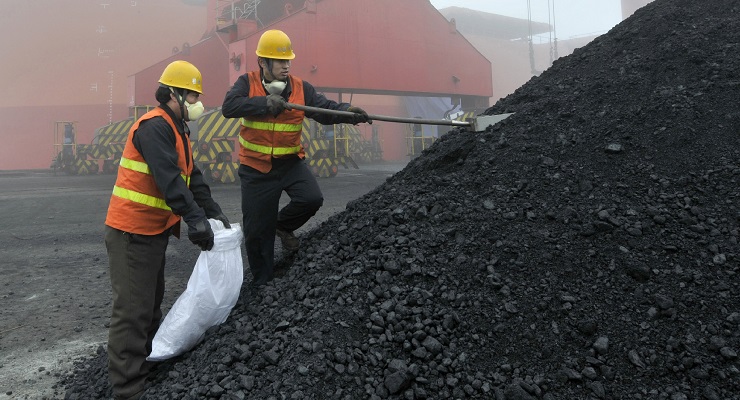
China’s petulant ban on imports of Australian coking and thermal coal has come back to bite it hard, with the country scrambling to avoid a power crisis as the northern winter approaches.
Last week and weekend saw a series of meetings in Beijing between the government and major energy groups aimed at trying to build sufficient energy reserves for residential heating in winter — while at the same time trying to avoid a surge in the prices of coal, gas and oil above the record levels amid blackouts and shutdowns caused by lack of power capacity.
Unusually, power shortages have attracted considerable media attention: the People’s Daily government media outlet reported on Sunday that a power shortage in the north-eastern industrial province of Liaoning was at a “severe level”, partly due to declining wind power (which has been a problem in Europe and the UK, along with a shortage of gas).
On Monday night, China Daily reported that Guangdong province had moved “to ensure steady power supply”, a rare admission that there is a problem at a province-wide level. Guangdong is China’s biggest and most important province in terms of population and business. China Daily revealed “many companies and factories have been ordered to operate for three days only, after having stopped production for four days, in the Pearl River delta, one of the world’s major production bases. Priority will be given to residential power consumers and the province’s service industries.”
The paper reported that demand for power in the province was up more than 17% this year and that was before the peak late summer-early autumn period, ahead of the surge in demand for heating starting in mid November.
That most virulent of all Chinese state media, The Global Times, also reported that:
A textile factory based in Jiangsu province received a notice from local authorities about power cuts on September 21. It won’t have power again until October 7 or even later … Guangdong issued an announcement on Saturday, urging tertiary industry users such as government agencies, institutions, shopping malls, hotels, restaurants and entertainment venues to conserve power, especially during peak hours.”
On Tuesday morning it followed up with:
“The unexpected and unprecedented power cut in three provinces in north-east China — Heilongjiang, Jilin and Liaoning — on Monday following reported electricity shortages have resulted in major disruptions to the daily lives of people and business operations, sparking growing concerns over the potential disruption of power supplies as demand booms ahead of the upcoming winter season.
“Power rationing in some parts of north-east China, particularly in some residential communities without advance warning, has sparked public anger and growing debate over China’s power supply. Some have questioned if the recent power cuts are an indication of a potentially large domestic gap in power supplies that could lead to an ‘energy crisis’.”
Other Chinese outlets have carried similar stories, reflecting not merely the magnitude of the crisis but the willingness of at least some within the Xi Jinping regime to question whether government decisions have played a role in the crisis.
Official newsagency Xinhua reported on Saturday that to make sure coal is delivered to regions that need it the most, producers and purchasers from China’s coal-dependent north-eastern regions met in Beijing on Saturday to lock in supply contracts for the winter heating season that starts on November 15 and runs to March 15.
But high market prices have put buyers under pressure. China’s National Development and Reform Commission said last Tuesday that it would send investigators to ensure that supply and price stabilisation measures were implemented properly across China, especially in coalmining provinces.
Much of that is to do with the ban on Australian coal imports and China’s inability to source high-quality coal elsewhere. Chinese coal imports fell to 198 million tonnes in the eight months to August, from 220 million tonnes for the same period in 2020, which is when the ban on Australian coal started. That helped drive up the price of thermal and coking coal (used in the steel industry) to record levels, as well as boosting the price of liquified natural gas (LNG) imported from Australia, Malaysia, Indonesia and the Middle East.
Chinese coal producers haven’t come close to meeting the supply gap, which has led to brownouts and rolling blackouts for much of the summer in areas of heavy industry. Output of steel, copper and aluminium has been impacted by the combination of the crackdown on carbon emissions and power shortages and blackouts.
Ahead of the start of the seven-day National Day break on Friday, China’s two start-of-month activity surveys on manufacturing and services is likely to show a further slowing in the pace of business, thanks to the power cuts and rationing, as well as the government’s demand for lower emissions ahead of the Glasgow COP26 climate conference. To meet the promise of the 3% cut in energy intensity this year, the central government has imposed cuts and quotas on provincial governments which in many cases have missed their targets.
The willingness of China’s tame media to report on the crisis, however, suggests there may be political, as well as economic, ramifications.









At Glasgow Xi will spin this as China cutting emissions.
Not hard given that their emissions are 50% of ours on a per capita basis.
China consumed around 3 billion tons of thermal coal per annum according to this recent article:
https://www.scmp.com/economy/china-economy/article/3147774/china-australia-relations-demand-coal-surges-how-long-can
Of this, approximately 2.7 billion tons was locally produced. The fall attributed to the boycott of Australian coal is something like 30 million tons – which does not seem to be a material quantity in the overall supply / demand equation.
What am I missing?
Billions of tons, or tonnes. By jingo, they’re big numbers.
Here’s Scotty’s chance to show his environment credentials and stick it to the Chinese at the same time. Refuse to increase coal exports to China. Somehow I can’t quite see it.
DF, was thinking that a particularly Machiavellian mind with a somewhat psychopathic streak and unheard of levels of brinkmanship could halt all exports of gas, coal and iron ore out of Australia for the next 6 months. Huge spike in world prices, economic bedlam, a long cold winter for China and probably a nuclear winter for whoever was left here, with a 1% chance of Jinping’s overthrow and China coming back to Australia saying all is forgiven now.
Not really thinking that. Chances of it ending well are about a billion to one. No doubt the CIA is working up such a plan as we speak.
Better not let certain members of the National Party see this article.
Regardless, there is no room for Australian triumphalism. That China was prepared to put their economy and image amongst their citizens at risk, in order to make a point to Australia, suggests the extent to which they are prepared to go when they are challenged. I’m not saying that Australia should kowtow to China, but it does mean we shouldn’t try and pick fights with them either.
We already did pick a fight with them.
Nah, they’re all over at Ltd News, although someone here called ‘Peril’ called me a gormless twat yesterday LOL. I’m sure he found his way back to his mates at the Sky After Dark.
It’s amazing how this worldwide shout out for help from fossil fuels, has manifested so quickly and on cue!